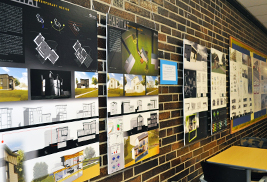Featured Article
Fashion Design Student Competes in 48-Hour Outdoor Wear Design Competition
Jillian Miranda, a Kent State senior fashion design student, will compete in Outdoor Retailer’s signature design competition in Utah.
read moreArchitecture Students Design Habitat for Humanity Dwellings in Columbiana County
Posted Jan. 21, 2013 | Tina Smith
Students from Kent State's College of Architecture and
Environmental Design created design concepts for the
Habitat for Humanity of Northern Columbiana County.
Their designs were displayed during a reception at the
Kent State Salem Campus.
Fourth-year students from the College of Architecture and Environmental Design may one day see their concepts take shape in the form of houses built by Habitat for Humanity of Northern Columbiana County.
Joe Ferut, assistant professor in the College of Architecture and Environmental Design, explains that 44 fourth-year architecture students teamed up last semester to create 22 designs that will be reviewed and considered by the Habitat for Humanity organization. The project came about through committee meetings to plan curriculum and to generate ideas for campus collaboration.
George Bigham of the Kent State College of Applied Engineering, Sustainability and Technology, is a committee member and teaches construction management. His mother, Judy Sicilia, serves on the Habitat for Humanity of Northeast Ohio board and is chair of the selection/support committee.
“This was a good fit for the fourth-year design studio and George’s cost estimating class,” Ferut says. “With his mom on the Habitat board, going to Salem made sense.”
Ferut explains that the students worked in teams of two and had three weeks to complete their designs. Each team had to generate a traditional and contemporary style design that is also user friendly and can be constructed using volunteer labor. Additionally, the designs must be very energy efficient and cost effective.
The designs had to meet specific Habitat requirements and fit on “real” existing sites, each with their own challenges. One building site is quite narrow, one is shaped like a slice of pie, and one has an uneven elevation.
According to Barbara Loudon, executive director of Habitat of Humanity of Northern Columbiana County, representatives met with the students and explained Habitat’s specifications and also explained how families qualify for these homes.
“We are so impressed with the results and that the students really understand their audience,” she says. “Our goal is to end up with plans that we can build from.”
Loudon notes that Habitat has built 33 homes in Columbiana County and is interested in different profiles to fit different families. “We are constantly looking for energy-efficient homes and for ways to make the home more affordable for the family. Sustainability is a major component,” she adds.
“We gave Habitat a lot of options,” says Ferut. “Not only were there three sites, but the students designed one- and two-floor homes with both three and four bedrooms. This project meant a lot to all of us, especially the students. They were asked to take their design skills and design real buildings for real people. That’s not something that happens very often in the academic environment.”
The students’ designs were showcased recently at a reception held on the Kent State Salem Campus. Habitat for Humanity will consider each design and select one, possibly two, designs that will be used in Columbiana County. Horticulture students from the Kent State Salem may be called upon to help with soil studies and landscaping.
Douglas Steidl, dean of the College of Architecture and Environmental Design, attended the reception and was pleased with what he saw.
“Habitat for Humanity is a wonderful organization and some of our designs can provide diversity and spatial excitement for their homes,” he says. “One of Kent State’s goals is to have a positive impact on the community and this project fits that footprint. Our students have hearts for serving and I think that is why these designs are so meaningful. Each could potentially be a future home for a deserving family. That’s special.”
